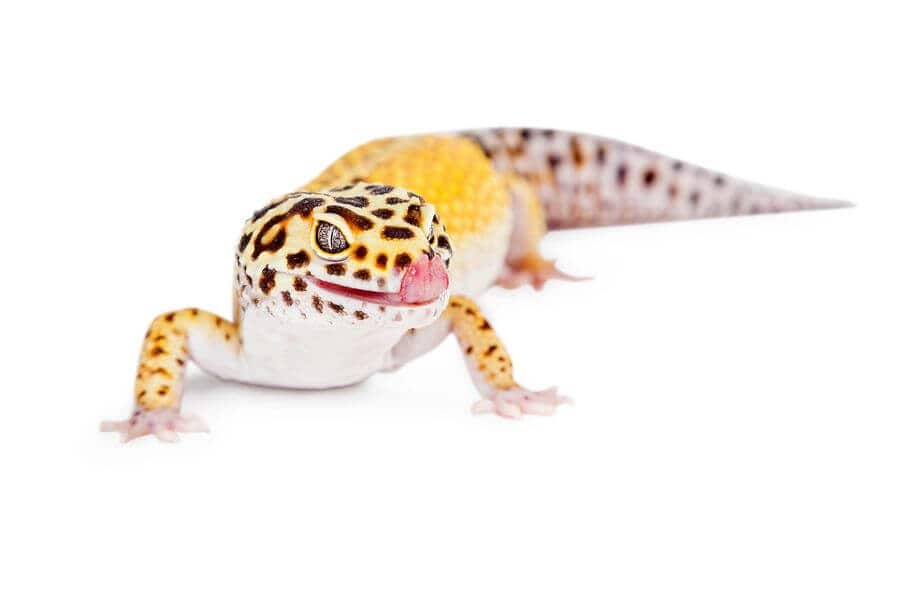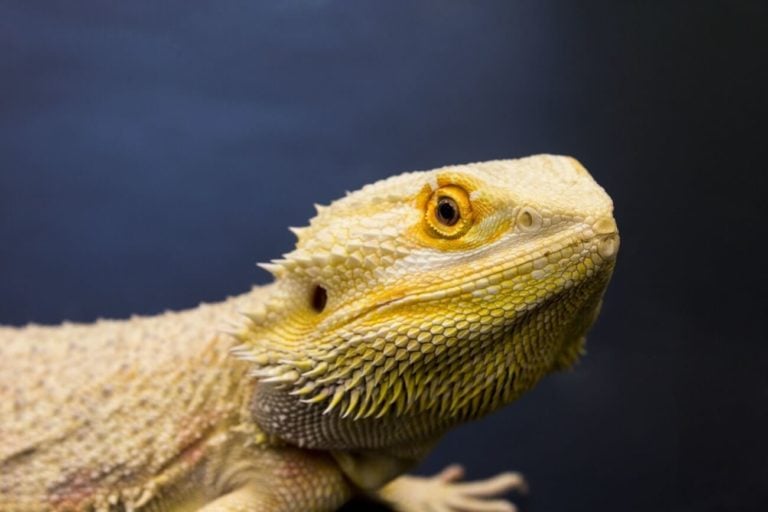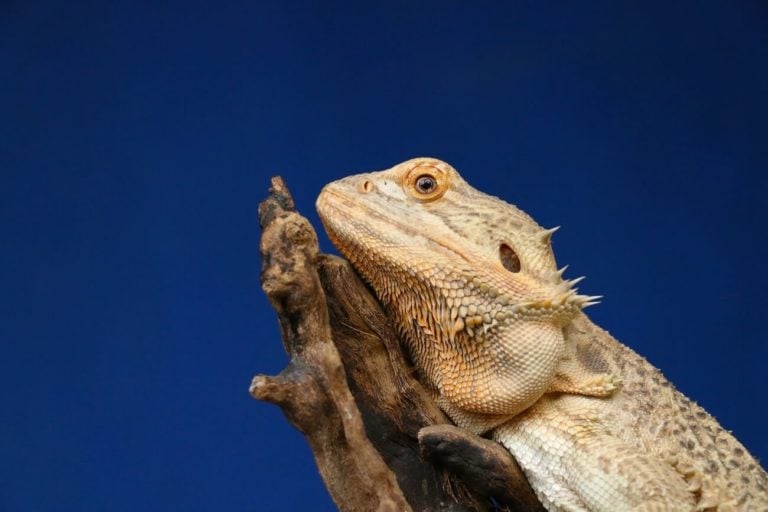Since leopard geckos are such popular and easily attainable pet reptiles, there are a number of common questions potential owners ask about them.
And “Do leopard geckos bite?” is certainly one of them!
This guide goes over everything you need to know about bites from these reptiles. You’ll learn about the likelihood of it happening, what to do in the event that you’re bitten, and how to prevent it from happening in the future.
Table of Contents
Do Leopard Geckos Bite?
Leopard geckos are beloved pets known for their easy-going nature. Because of that, most people would never think these lizards can bite.
But they definitely can!
Leopard geckos are fully capable of biting you. Fortunately, biting is a rarity for this species. Bites are very uncommon, and they typically only occur if the lizard has a good reason for its actions.
Why Leopard Geckos Bite
There are several reasons why a leopard gecko might bite you. While we can’t get into the mind of your leo to know for sure, several factors could make the reptile more agitated and likelier to show aggression.
Here are some of the common reasons why this could happen.
1. Your Leopard Gecko Simply Wants Some Privacy
One of the most common reasons leopard gecko bites occur is because they want peace and privacy. For the most part, this reptile species tolerates handling quite well. They’re mostly docile and rarely show aggression like other good pet lizard species.
But like every other animal, there are limits to what a leopard gecko will tolerate. If you bother your lizard too much, it might give you a warning with a soft bite!
It’s important to remember that leopard geckos are crepuscular creatures. That means they’re most active in the dawn and dusk hours. These creatures may be active during the day, but you’ll likely see them lounging and relaxing.
Sometimes, trying to handle a leopard gecko outside their busy hours interrupts their sleep. They may be low on energy and wanting nothing more than to relax, and reaching your hand into the enclosure to hold them ruins that.
In these cases, all your leopard gecko wants is privacy. So, it’s best to give them their space.
2. They’re Not Used To You Yet
Contrary to popular belief, leopard geckos aren’t willing to be handled right out of the gate. They need time to adjust to their new environment and their new owner.
Leopard gecko bites are most likely to occur within the first few weeks of bringing your gecko home. Some new owners may get bit after setting up their lizard’s new home and moving them into the tank. This happens because the gecko isn’t used to your presence.
As far as they know, you’re a would-be predator! Leopard geckos are naturally defensive in the beginning. They’d much rather run and hide, but can bite when faced with what they think is sure death.
To avoid getting bit, give your leopard gecko time to feel comfortable in their new home. Most experts recommend not handling the gecko for at least two weeks. You still need to clean the enclosure and feed the gecko, but you should avoid trying to handle them.
Keep the interactions light and stress-free. Over time, your gecko will realize you’re not there to hurt them. They’ll get more comfortable with your presence, placing their trust in you.
It takes time. Even after the initial introductory period, limiting handling sessions is important. Work your way up slowly, and don’t push your gecko beyond its comfort zone.
3. Territorial Behavior
Leopard geckos can be surprisingly territorial. That’s why keeping more than one lizard in the same enclosure is not a good idea.
Pairing two males is asking for trouble. While some female pairs can work, there’s still a risk that they’ll fight one another.
Generally, a leopard gecko won’t see you as much of an invader once it gets comfortable with your presence. But if you creep too much into its space, you’ll see the lizard’s territorial side emerge.
One common scenario occurs when you own multiple leopard geckos in different enclosures. If you were to pet one and not wash your hands, its scent can linger. So when you reach your hand into another gecko’s tank, it’ll smell the scent of another lizard and go into territorial mode.
Don’t let the reptile’s small size fool you. If it ever feels it needs to defend its claimed territory, it’ll do so with biting.
4. Mating Behavior
There’s a higher chance of a leopard gecko bite occuring during this reptile’s mating season. Mating occurs in the summer when females become gravid. While leopard geckos can be defensive and territorial in certain situations, this worsens around mating time.
Expert Tip: Breeders are the only ones who should keep a male and female in the same tank. That’s because they know how to navigate the lizards’ unique behavior.
The temperament of male leopard geckos changes when mating. They get more protective over gravid females, and simply putting your hand in the enclosure could encourage them to bite you. They want to protect the female and her potential eggs.
Males also want to ensure you don’t interrupt their courting.
Fortunately, this behavior usually subsides after mating when males get put back into a separate tank.
5. They’re Hungry
Hunger can turn an otherwise calm leopard gecko into a biting machine! Biting is still rare when you feed your gecko on a regular schedule. But if it’s been a few days since your lizard last ate, they can become overeager.
In these cases, biting isn’t purposeful. It’s usually because they mistake your finger for an insect!
Your finger is larger than mealworms and other feeder insects, but it’s close enough for a gecko to mistake. They get overexcited and will try to eat your finger! Fortunately, they realize their mistake quickly and let go.
A leopard gecko may also bite you if you have leftover calcium or multivitamin powder on your finger. Dusting insects with supplement powders ensures your gecko gets the necessary nutrients. They don’t mind the powder and often connect the look and texture with food.
So, having some stray powder on your finger will make them mistake you for food.
If you feed your leopard gecko by hand, they can also accidentally bite you when lunging for food. While they’re pretty agile and quick on their feet, leopard geckos don’t have perfect aim. It’s common for them to overshoot, accidentally biting the hand that feeds.
6. Self-Defense
Finally, leopard geckos can bite you if they feel threatened. There are many reasons why this could happen.
Sometimes, owners pick their lizards up incorrectly. For example, you might inadvertently pinch the gecko’s sides or pull too hard on one body part. There’s an art to handling leopard geckos.
Your actions could be uncomfortable or downright painful if you don’t support and grab their weight correctly. Those sensations will make your gecko think it’s being attacked, causing them to bite in retaliation.
Some leopard geckos may also have a history of abuse. Even ones from well-known breeders might have spent several months without socialization or lived in rough conditions. That neglect puts them on edge.
They stay on alert and are more likely to bite without provocation. These lizards can learn to trust again, but it may take longer to get there. In the meantime, they may bite you whenever they feel scared and threatened.
It’s a defense mechanism, one of many. In addition to biting you, your leopard gecko could drop its tail. It regrows over time, but tail-dropping is a tell-tale sign that your lizard doesn’t feel safe.
Do Leopard Gecko Bites Hurt?
We have good news if you’re worried about the pain of a leopard gecko bite. Leopard gecko bites generally don’t hurt much, and most people don’t consider them to be very painful.
Of course, pain is subjective. However, most owners compare the feeling of a leopard gecko bite to being pinched. It’ll catch you by surprise, but it’s not bad. Many people don’t even realize they got bit!
You must remember that leopard geckos are small. The biggest specimen reaches 11 inches from snout to tail. But many only reach lengths of about seven or eight inches.
Because they are small, leopard geckos don’t have a significant bite force. They have the power they need to consume insects, but they’re incapable of doing much damage to a human.
Juvenile leopard geckos are more likely to bite you, but their bite force is even lower than adults.
You may feel more discomfort if your gecko decides to latch onto you when they bite. However, most bites are accidental, and the lizard will let go quickly when it realizes it has made a mistake.
Is It Common For Leopard Gecko Bites To Draw Blood?
Technically, a leopard gecko can draw blood. But is that likely to happen?
Seeing blood after getting bit by a leopard gecko is even rarer than receiving a bite. These geckos have about 100 tiny teeth. They’re far too small and delicate to penetrate deep into the skin.
Of course, there are exceptions. You may see a bit of blood if you’re bitten in a sensitive area with thin skin, such as the webbing between your fingers. The same goes for when a gecko latches onto your skin. When they hold on, you might try to twist your hand to break them free, causing their teeth to rake through the skin and draw blood.
What To Do If Your Leopard Gecko Bites You
If your leopard gecko bites you, there are a few things you should do.
The first is to remain calm. The bite can catch you off guard, but don’t let that surprise cause you to fling your lizard away. That can seriously injure them.
If your lizard latches onto your skin and won’t let go, attempting to pull or throw them off could cause the teeth to sink deeper. It increases your chances of seeing blood. Furthermore, the movement could rip the gecko’s teeth out, resulting in serious injury and a higher risk of infection for your lizard.
Just stay relaxed and allow your leopard gecko to release when they’re ready. Most won’t hold on for more than a second. If you stay calm, they’ll see they have no reason to worry and release.
In the event they keep holding on, you can run some clean water over your leopard gecko’s mouth. The sensation will cause them to relax and release.
Once your gecko is no longer biting you, gently put it back in its enclosure and inspect the wound.
In most cases, you’ll see nothing but some faint teeth marks. However, in the rare instances when a bite draws blood, clean the wound. There’s a risk of infection on your part, so you’ll need to practice good first aid until the bite heals.
Should You Be Worried If You’ve Been Bitten?
Leopard geckos aren’t venomous, so there’s no worry about poison. It’s still smart to remain vigilant about keeping the wound clean until it fully heals, but you shouldn’t be concerned.
There’s a good chance that you’ll quickly forget about the bite. They’re virtually painless. The best thing you can do is think about why your leopard gecko bit you and try to avoid putting them in the same situation again.
Ways To Prevent This From Happening In The Future
Always be wary of your leopard gecko’s mood and temperament.
When bringing them home and introducing them to a new environment, give them space and time. Wait several weeks before you begin directly interacting with your new pet regularly. It needs time to feel things out and get comfortable.
If you try to push your lizard, you can stress it to the point where it feels the need to be defensive. Build trust and slowly work your way up from behind-the-glass observation to physical handling.
Consider using tongs and a food dish to avoid getting bit during feeding time. It’s also wise to wash your hands to remove any powder or scents.
When housing a leopard gecko, ensure it has plenty of space. Avoid housing multiple geckos together to keep territorial behaviors at bay.
Conclusion
While leopard geckos do bite, it’s not something you should worry about. If you’re respecting your lizard and handling it with care, bites will almost never happen.
And if they do, they don’t hurt!
We hope you found this guide useful and feel more confident about handling your pet in the future. If you have any questions, you’re always welcome to ask!



